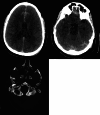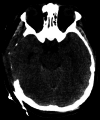Use of extracorporeal membrane oxygenation during a decompressive hemicraniectomy for severe traumatic brain injury: illustrative case
- PMID: 39467308
- PMCID: PMC11525767
- DOI: 10.3171/CASE24264
Use of extracorporeal membrane oxygenation during a decompressive hemicraniectomy for severe traumatic brain injury: illustrative case
Abstract
Background: Decompressive hemicraniectomy (DHC) can be a life-saving treatment for patients with severe traumatic brain injury (TBI) with a focal mass lesion who develop refractory elevated intracranial pressure (ICP). Nonetheless, successful completion of this procedure requires maintaining hemodynamic and respiratory stability. Extracorporeal membrane oxygenation (ECMO) use in patients with respiratory or cardiac failure is well described in the literature and has become routinely used in patients with refractory hypoxia unresponsive to traditional mechanical ventilation strategies, but few cases of its use have been reported in the neurosurgical literature.
Observations: Herein, the authors describe a unique case in which a man presented after an unwitnessed fall that caused severe TBI without a focal mass lesion. The patient subsequently developed medically refractory elevated ICP secondary to traumatic cerebral edema. He required DHC, but the procedure could only be completed safely with the utilization of intraoperative ECMO.
Lessons: As more is learned about the techniques and pitfalls of ECMO, its indications are rapidly expanding. The case presented describes the safe use of ECMO during a major neurosurgical procedure, showing that the technique can be completed safely and offering a therapeutic option for effectively addressing refractory hypoxia and hypercarbia in patients with severe TBI who require urgent or emergency neurosurgical procedures. https://thejns.org/doi/10.3171/CASE24264.
Keywords: case report; decompressive hemicraniectomy; extracorporeal membrane oxygenation; traumatic brain injury.
Figures




References
-
- Heck C. Decompressive hemicraniectomy in the stroke patient. Crit Care Nurs Clin North Am. 2023;35(1):67-81. - PubMed
-
- Smith M. Refractory intracranial hypertension: the role of decompressive craniectomy. Anesth Analg. 2017;125(6):1999-2008. - PubMed
-
- Crudele A, Shah SO, Bar B. Decompressive hemicraniectomy in acute neurological diseases. J Intensive Care Med. 2016;31(9):587-596. - PubMed
-
- Hawryluk GWJ, Rubiano AM, Ghajar J. Guidelines for the management of severe traumatic brain injury: 2020 update of the decompressive craniectomy recommendations. Neurosurgery. 2021;88(4):E372-E373. - PubMed
LinkOut - more resources
Full Text Sources
Research Materials

